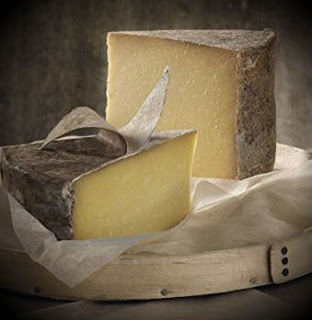Cheddar cheese starts with a process of heating the milk and adding rennet, an enzyme that helps form the curd. After the whey is poured off, the curds are left to drain and eventually knit together in a cheesecloth. The mass is removed from the cloth and sliced into small loaves that are stacked on top of each other, allowing more moisture to drain. This process of stacking the loaves is called cheddaring, and it affects both the texture and the flavor of the cheese. Cheeses created using this method tend to be dry and layered in their texture, and the flavor is usually less acidic than cheeses with more moisture.
The story goes that in 2003, Cabot creamery partnered with Jasper Hill to create a particular cloth-bound cheddar. Developing cheese flavor doesn't depend solely on the age of the cheese; it also depends on how the cheese is aged. That's where Jasper Hill steps in and shines. Wrapping a wheel of cheese in cloth as it ages reduces the loss of moisture and helps to develop a hard, natural rind that protects the interior. These days, many companies use wax, which works well to keep the innards moist but prevents mold and, as a result, more subtle flavors from developing. In fact, the good folks at Jasper Hill rub lard on the young cheddar from Cabot Creamery in order to support mold growth as the cheese ages for about a year on spruce shelves. There's no lack of complexity in this cheese.
 |
| Cabot Clothbound has a natural rind. |
When you think of cheddar cheese in the United States, you often think of the classic yellow, oily dairy product that has a slightly sharp tang but is more often than not one-dimensional. Cabot's white clothbound cheddar is wax-covered, yellow cheddar's sophisticated and more mature cousin. It's understated but intriguing and, despite its straight-laced first impression, attractive in its covert complexity.
 |
| The slightly dry interior is pale but flavorful. |
Cabot Clothbound is an award-winning cheese with a dry, slightly crumbly texture. Its aroma is beautifully balanced, not too funky and not too bland. It's milky and inviting. The natural rind offers earthy notes, but the overall flavor is light and well balanced with a nutty, sweet, caramel finish. The classic cheddar tang is bright, tart and apparent, but there are subtle milky undertones that make this cheese a winner. The savory-sweet combination makes this cheddar the perfect cheese to pair with nearly any dish, hot or cold. Cheese straws made with Cabot Clothbound are divine.
Serve Cabot Clothbound cheddar with crisp apple slices, on a cheese and charcuterie board, or by itself with a side of homemade potato or sweet potato chips. Though it's not the best slicing cheese, it still goes well on sandwiches, grilled or cold. Use this cheese in any recipe that calls or cheddar or a mixture of cheeses. Don't forget to add a piece to a slice of warm apple pie for dessert.
 |
| Cider pairs well with Cabot Clothbound. |
Unlike some of the big, bold, extra-sharp cheddars that can handle a powerful wine, Cabot Clothbound does better with medium-bodied wines, though there's no real bad match when it comes to this cheese. If you do go for a Cabernet, you might want to stick with a low-tannin, fruity Chilean or Australian type. Try serving this cheese with Pinot Blanc, Friulano, Nebbiolo, Syrah, Zinfandel, or a tawny or ruby Port. You won't be disappointed if you pour yourself a nice brown ale as an accompaniment, and a sparkling cider pairs exceptionally well, too.